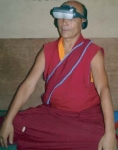Sep 05, 2005
Meditation alters perceptual rivalry in Tibetan Buddhist monks
reported in the June 7 issue of Current Biology their results from a series of experiments with 76 monks in Ladakh. The goal of their research was to investigate how certain type of meditation can Researchers found that the skills developed by Tibetan Buddhist monks in their meditation practice strongly influence their experience of binocular rivalry, a perceptual phenomenon that occurs when the brain alternates between viewing different images presented to each eye. The neural processes underlying perceptual rivalry are still unclear but they are thought to be linked with brain mechanisms that regulate attention and conscious awareness.
76 Tibetan Buddhist monks participated in the study. The researchers tested the experience using binocular goggles that prompt visual rivalry. The researchers found that the use of a specific meditation technique, called “one-point meditation” determined a high rate of perceptual dominance. In other words, when they used that technique the normal switching processes of binocular rivalry slowed considerably. This observation suggests that individuals who have trained themselves in meditation techniques can alter the normal fluctuations in the states of their consciousness.
More to explore
Carter, O.L., Presti, D.E., Callistemon, C., Ungerer, Y., Liu, G.B., and Pettigrew, J.D. (2005). Meditation alters perceptual rivalry in Tibetan Buddhist monks. Current Biology, Vol. 15, June 7, 2005, pp. 412-413.
16:20 Posted in Meditation & brain | Permalink | Comments (0) | Tags: Positive Technology, meditation







The comments are closed.